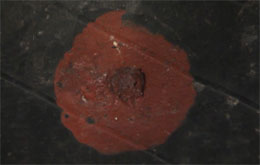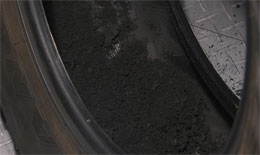Tire Problems
Tires aren’t always black and round, this one is a good example. The driver of this vehicle experienced a severe vibration, or shimmy, or shake. Different people describe these sensations differently. But, the reality of it is that the tire, at highway speeds, was almost hopping up and down off the ground. Well, come to find out, it was not a bad shock absorber, it was not an out of balance tire, it was a tire with a slipped or broken belt, as we can see by this great big bulge. Now the lesson here is, if all of the sudden you get a shake or a vibration at highway speeds in the vehicle, or at low speeds, the car tends to kind of rock back and forth, always check the tires to make sure that they are round. This is not uncommon.
 Alright, another thing, you have a flat tire, you find that something has punctured the tire, the air has leaked out. Don’t do what so many people do: they take a plug, they shove it through tire, they put air in it, and they go merrily along their way. That should never happen. Now, what do you need to do? Well, if you just put a plug through it, it seals the inside or the outside of the tire, one or the other, but it doesn’t seal both. And you have to seal both.
Alright, another thing, you have a flat tire, you find that something has punctured the tire, the air has leaked out. Don’t do what so many people do: they take a plug, they shove it through tire, they put air in it, and they go merrily along their way. That should never happen. Now, what do you need to do? Well, if you just put a plug through it, it seals the inside or the outside of the tire, one or the other, but it doesn’t seal both. And you have to seal both.
You see, there’s more to it than just keeping the air in the tire. You have to keep water from entering the tread around the hole, because it’ll get it around the steel belts, and rust the belts. You have to seal the inside of the tire, so that air doesn’t migrate in between the plies of rubber and fabric in the tire. So that means a plain old plug? No. A plain patch inside? No. A patch/plug, which goes from the inside and has a plug attached to it, that’s fine. Or a plug, combined with an internal sealant does a good job. The big thing is, that you’re going to seal the inside and the outside of the tire. And if you think about this, every time you do one of those proper repairs, you have to take the tire off of the wheel. And that is an important part. You should never, ever drive on a tire that has been run, even a very short distance, underinflated, without removing it and inspecting the inside of it.
 Now, this tire down here, we can see that it looks pretty wrinkly and so on, but on a wheel, with air in it, it would look normal. Yet if we hadn’t taken that tire off of the wheel, if we had just plugged it and put air in it, well we wouldn’t have seen this: This is rubber, this whole jar full, of ground up rubber from the inside of that tire. Had we just done the old plug routine, well probably out on the highway it would have come apart, and wound up looking like this tire. Very dangerous. And if you have a question or comment, drop me a line. Right here, at MotorWeek.
Now, this tire down here, we can see that it looks pretty wrinkly and so on, but on a wheel, with air in it, it would look normal. Yet if we hadn’t taken that tire off of the wheel, if we had just plugged it and put air in it, well we wouldn’t have seen this: This is rubber, this whole jar full, of ground up rubber from the inside of that tire. Had we just done the old plug routine, well probably out on the highway it would have come apart, and wound up looking like this tire. Very dangerous. And if you have a question or comment, drop me a line. Right here, at MotorWeek.





